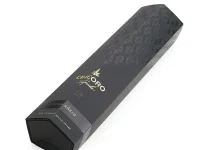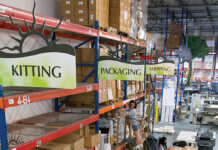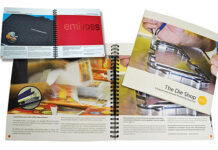by Jen Clark, The Binding Edge
 Like most trade binderies, Allied Bindery has observed trends in smaller run quantities, quicker turn-around time requirements, changing raw materials and an overall reduction in marketplace demand as the digital world continues to expand. To place the company apart from the competition, Allied Bindery set a high standard of customer satisfaction, added service capabilities and provided customers with the opportunity for one-stop shopping for virtually all their finishing needs.
Like most trade binderies, Allied Bindery has observed trends in smaller run quantities, quicker turn-around time requirements, changing raw materials and an overall reduction in marketplace demand as the digital world continues to expand. To place the company apart from the competition, Allied Bindery set a high standard of customer satisfaction, added service capabilities and provided customers with the opportunity for one-stop shopping for virtually all their finishing needs.
The addition of ISO certification in 2002 put the company, located in the Detroit metro area, on a path to pursue excellence and deliver results for the benefit of its customers. It has expertise in a broad line of trade bindery finishing services and provides flexibility in its operations by always looking for ways to say “yes” to customers, said Ed Doyle, Allied Bindery’s managing director.
While it serves many markets, a large portion of Allied Bindery’s revenue comes from the automotive sector. “The automotive industry is our largest vertical market, accounting for over half our revenue,” he said. “We are two-up, small book specialists. We provide up-front design collaboration with our customers and have the most extensive error proofing and quality assurance systems in the industry.”
“They saw a need …”
 Allied Bindery was founded in 1986 by Frank Cancro and Dan Maliniak in Madison Heights, MI. Both had extensive experience in the printing industry and were entrepreneurial in nature. “They saw a need and opportunity for a top-quality trade bindery to serve the southeast Michigan print community,” Doyle said. The company grew out of its original location and moved to its current home – a 50,000 square foot warehouse-style facility – in 1995. “We have a pretty unique building,” Doyle said. “It can accommodate the influx of work we get, but also we can store items for customers in our warehouse space for later delivery.”
Allied Bindery was founded in 1986 by Frank Cancro and Dan Maliniak in Madison Heights, MI. Both had extensive experience in the printing industry and were entrepreneurial in nature. “They saw a need and opportunity for a top-quality trade bindery to serve the southeast Michigan print community,” Doyle said. The company grew out of its original location and moved to its current home – a 50,000 square foot warehouse-style facility – in 1995. “We have a pretty unique building,” Doyle said. “It can accommodate the influx of work we get, but also we can store items for customers in our warehouse space for later delivery.”
Allied Bindery established a reputation for excellence and quality, “which continues to this day,” Doyle noted. As the owners neared retirement age, the company was sold to a group of six investors in 1999, with Doyle taking the helm. “Our background is in the auto supply business,” he said of his fellow investors. “We saw opportunities where we could enhance systems to what Allied Bindery already provided. We went through a due diligence process and felt there was an opportunity for growth. Allied had a good track record leading up to the sale. The company was well established and had a good reputation in the marketplace, which made it an attractive asset.”
Over the years, the company expanded its clientele to include customers in Ohio, Indiana and throughout all of Michigan, “with several national accounts as well,” Doyle added. For the automotive industry, Allied Bindery creates automotive manual-related products that find their way into the glove boxes of American-, German- and Japanese-manufactured vehicles. “We make millions of those books every year, but there really is no “typical job,” Doyle said. “While our processes are highly systematized, trade finishing remains custom work. Each job utilizes unique raw materials and poses unique challenges to finish on time and to the customer’s required quality level. This is consistently achieved by an experienced and talented employee group.”
After the ownership change, Allied Bindery pursued and achieved ISO 9001:2000 status, and in 2008, updated to the ISO 9001:2008 standard. According to the International Organization for Standardization, ISO certification ensures that materials, products, processes and services are fit for their purpose. It provides strategic tools that reduce costs by minimizing waste and errors, as well as increase productivity.
“Part of the adoption of our ISO system is a culture of continuous improvement in all aspects of our business processes,” Doyle explained. “It is a task that is constantly pursued, yet by definition, is never completed. We constantly encourage our customers to provide comments and suggestions to help ensure the best possible quality and value throughout the supply chain.”
Allied Bindery employs 35 people across two shifts covering 24 hours a day, but adds contract and temporary employees “as business conditions warrant,” Doyle said. “We have a lot of long-time employees. There are people here who were here when we bought the company. We have a lot of good, talented people, and we have a very accommodating and flexible workforce.”
Working toward a “Zero Defect” environment
Allied Bindery’s current capabilities include perfect binding with PUR and hot melt adhesive, as well as layflat, notch and tape binding. Additional trade bindery services include cutting, folding, saddlestitching, loop stitching, shrinkwrapping, round cornering, drilling, collating and fulfillment. Mechanical binding services include twin loop (wire-o), semi-concealed wire-o, concealed wire-o, plastic coil, tab cutting, Mylar reinforcing and calendar tinning. Mechanical binding and special project services were added in 2011, while calendar tinning was added in 2012.
The company utilizes two Kolbus perfect binders – 20- and 28-pocket collator and binder systems, which give Allied Bindery the opportunity to handle very large projects. In addition, the bindery runs Muller Martini saddlestitchers, MBO folding equipment, a Polar cutting system from Heidelberg and various pieces of mechanical binding equipment. As part of its on-going commitment to quality, Allied Bindery has invested heavily in numerous error-proofing technologies. “We view these technologies as “killer apps,” Doyle said. “They kill problems before they ever have the chance to reach our customers.”
It was the first trade bindery in the upper Midwest to implement OptiGraph digital camera signature recognition systems on perfect binding lines; integrate high-speed computerized weigh scales into perfect binding lines; and design and integrate high-speed video cameras into perfect binding lines to detect and remove skewed or improperly registered books from the production stream. In addition, Allied Bindery also was the first trade bindery in North America to implement a ProControl adhesive application sensor and measurement system on perfect binding lines. Other technologies include electronic sensors and mechanical calipers to automatically detect incorrect signature pocket feeds and integrated electronics that automatically shut down production equipment when triggered by error-proofing devices.
Allied Bindery’s goal is zero defects, but like any trade binder, it is subject to the raw materials it is provided. “That plays a large part in quality and productivity,” Doyle said. “We have nine or 10 individual checks and balances, so our issues are very minor. The core issues of pagination and adhesion have been eliminated from our business as a problem.” These internal quality control standards have become an effective tool, he added. “Our system is designed to catch a mistake quickly – hopefully always before it gets to a customer.”
Developing a better adhesive
In 2003, the company adopted PUR adhesive technology in its perfect binding operations, partnering with Nordson Corporation and Henkel Adhesives in implementing the first extrusion slot delivery system at a trade bindery in North America. “At the time it was very new technology,” Doyle said, noting it had been tried in Europe. “The process was developed by Nordson. We did different trials and worked with different formulas for about a year before we installed it.”
Doyle said a trend within the printing industry led Allied Bindery to seek a new way of handling PUR material. “There were a lot of different materials being sent our way that weren’t virgin paper material. There was a need for a more robust adhesive technology than hot melt. PUR adhesive fits the bill well because it will adhere to anything, but it has unique characteristics when you process it.”
Once PUR adhesives get exposed to humidity in the atmosphere, he explained, it starts to cure. “Unless you’re running 24 hours, you’re forced to drain that pot each night and clean it out,” Doyle said. Because the extrusion system is a closed system, the adhesive isn’t exposed to the atmosphere until it goes on the book, he explained. In addition, it eliminates wasted glue, and clean-up time is reduced each night. “It is a very, very quick process at the end of the day,” Doyle said, “but maintaining it on a preventative basis is important. If you take care of your system, it will take care of you.”
Allied Bindery also has served as a beta test site, working with equipment and material vendors in jointly developing quality-based application technologies and serving as an industry leader in implementation. For example, in conjunction with Henkel, Allied Bindery has undertaken a long-term research and development project to improve PUR adhesive performance characteristics, helping to develop the next generation of PUR products.
“One of the issues with PUR is while the final cure is much stronger and durable, it doesn’t cure as immediately as hot melt,” Doyle said. “When you run a book with PUR, it needs to cure before being handled, whereas with hot melt it is ready immediately.” Curing time can vary depending on the time of year. Doyle said it can be as much as 24 hours in the winter, but eight to 10 in the summer.
“We’re continuing to work with Henkel so the company can modify its chemical formulas to try and get the adhesive to cure faster without losing its flexibility,” he said. “It is something that has improved over the years, but isn’t quite there yet.”
Customer service takes center stage
 Customer service starts with proactive, high-quality communication that results in mutual understanding with customers from original estimate through design assistance, current job status, pre-notification of all observable print-related issues prior to the addition of finishing costs and final shipment timing notification.
Customer service starts with proactive, high-quality communication that results in mutual understanding with customers from original estimate through design assistance, current job status, pre-notification of all observable print-related issues prior to the addition of finishing costs and final shipment timing notification.
Partnering with like-minded firms, Allied Bindery also provides solutions for customers by acting as a project manager for all postpress finishing needs, delivering jobs within the quality, delivery and cost parameters required by its customers. “The traditional print world is challenged with digital displacement,” he said. “We have to be a low-cost producer. We have to utilize our quality to attract new customers. We have to be careful because we cant do things that will compete with our customers – the print community.”
 Doyle said Allied Bindery has become a high-volume assembler or manufacturer of small items. “We can do small types of assembly with the things that we create. We look for partnerships with marketing firms or advertising agencies to utilize those skills,” he said. “We’re not going to become a software company – that’s not our core capability.”
Doyle said Allied Bindery has become a high-volume assembler or manufacturer of small items. “We can do small types of assembly with the things that we create. We look for partnerships with marketing firms or advertising agencies to utilize those skills,” he said. “We’re not going to become a software company – that’s not our core capability.”
In addition, it provides customers access to internal trucking operations to pick up and/or deliver customer materials within a 100- to 150-mile radius 20 hours a day to meet the most time-sensitive customer needs. “We’ve invested heavily in it,” Doyle said of the trucking operation. “It helps give us a competitive advantage and allows for flexibility.”
Allied Bindery has won numerous awards for its workmanship and commitment to its customers. It has been recognized by a southeast Michigan-based printer, operating globally, as its “Supplier of the Year” five years in a row. The Detroit Club of Printing House Craftsmen has awarded Allied Bindery gold and silver awards for “Superb Craftsmanship in Production” over the last several years; and in 2010, the Printing Industries of Michigan recognized Allied Bindery with three Gold Ink Awards. It also earned a “Certificate of Merit” for Product Excellence from the Binding Industries Association.
Doyle said the company’s goal moving forward is to continue “to delight our customers every day with outstanding service, communication, collaboration, quality and value. There is no substitute for excellence in the blocking and tackling of everyday business processes, especially those that directly impact our customers.”




